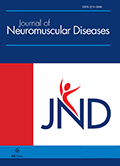Authors: Westra, Dineke | Schouten, Meyke I. | Stunnenberg, Bas C. | Kusters, Benno | Saris, Christiaan G.J. | Erasmus, Corrie E. | van Engelen, Baziel G. | Bulk, Saskia | Verschuuren-Bemelmans, Corien C. | Gerkes, E.H. | de Geus, Christa | van der Zwaag, P.A. | Chan, Sophelia | Chung, Brian | Barge-Schaapveld, Daniela Q.C.M. | Kriek, Marjolein | Sznajer, Yves | van Spaendonck-Zwarts, Karin | van der Kooi, Anneke J. | Krause, Amanda | Schönewolf-Greulich, Bitten | de Die-Smulders, Christine | Sallevelt, Suzanne C.E.H. | Krapels, Ingrid P.C. | Rasmussen, Magnhild | Maystadt, Isabelle | Kievit, Anneke J.A. | Witting, Nanna | Pennings, Maartje | Meijer, Rowdy | Gillissen, Christian | Kamsteeg, Erik-Jan | Voermans, Nicol C.
Article Type:
Research Article
Abstract:
Background: Neuromuscular disorders (NMDs) are clinically and genetically heterogeneous. Accurate molecular genetic diagnosis can improve clinical management, provides appropriate genetic counseling and testing of relatives, and allows potential therapeutic trials. Objective: To establish the clinical utility of panel-based whole exome sequencing (WES) in NMDs in a population with children and adults with various neuromuscular symptoms. Methods: Clinical exome sequencing, followed by diagnostic interpretation of variants in genes associated with NMDs, was performed in a cohort of 396 patients suspected of having a genetic cause with a variable age of onset, neuromuscular phenotype, and inheritance pattern. Many
…had previously undergone targeted gene testing without results. Results: Disease-causing variants were identified in 75/396 patients (19%), with variants in the three COL6 -genes (COL6A1, COL6A2 and COL6A3 ) as the most common cause of the identified muscle disorder, followed by variants in the RYR1 gene. Together, these four genes account for almost 25% of cases in whom a definite genetic cause was identified. Furthermore, likely pathogenic variants and/or variants of uncertain significance were identified in 95 of the patients (24%), in whom functional and/or segregation analysis should be used to confirm or reject the pathogenicity. In 18% of the cases with a disease-causing variant of which we received additional clinical information, we identified a genetic cause in genes of which the associated phenotypes did not match that of the patients. Hence, the advantage of panel-based WES is its unbiased approach. Conclusion: Whole exome sequencing, followed by filtering for NMD genes, offers an unbiased approach for the genetic diagnostics of NMD patients. This approach could be used as a first-tier test in neuromuscular disorders with a high suspicion of a genetic cause. With uncertain results, functional testing and segregation analysis are needed to complete the evidence.
Show more
Keywords: Neuromuscular diseases, exome sequencing, genetics, neurology, myopathies
DOI: 10.3233/JND-180376
Citation: Journal of Neuromuscular Diseases,
vol. 6, no. 2, pp. 241-258, 2019
Price: EUR 27.50




